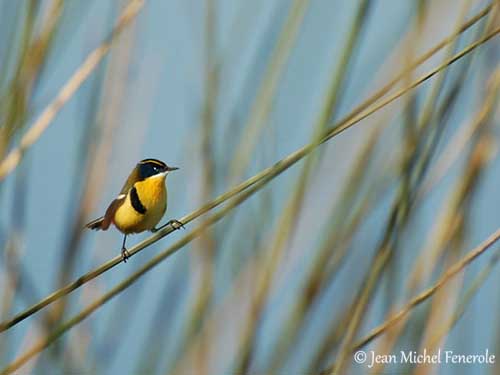
Fr : Tyranneau omnicolore
Ang : Many-coloured Rush-Tyrant
All : Vielfarben-Tachurityrann
Esp : Sietecolores - Tachurí sietecolores
Ita : Tiranno ventrerosso
Nd : Ornaattachuri
Sd : Vasstyrann
Port (Brésil) : Papa-piri
Photographers :
Roger Ahlman
Pbase Galleries Peru and Ecuador
Jean Michel Fenerole
Photos d’Oiseaux du monde
Text by Nicole Bouglouan
Sources:
HANDBOOK OF THE BIRDS OF THE WORLD Vol 9 - by Josep del Hoyo - Andrew Elliot - David Christie - Lynx Edicions - ISBN: 8487334695
BIRDS OF SOUTH AMERICA – Passerines - by Robert S. Ridgely and Guy Tudor – HELM Field Guides – ISBN: 9781408113424
BirdLife International (BirdLife International)
Birding Patagonia – Adventure expeditions
Neotropical Birds – Cornell Lab of Ornithology
Wikipedia, the free encyclopaedia

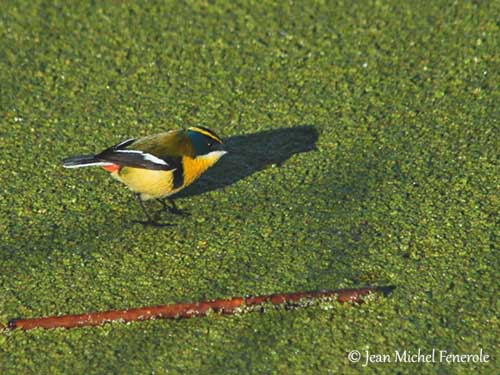
Many-coloured Rush-Tyrant
Tachuris rubrigastra
Passeriformes Order – Tyrannidae Family
INTRODUCTION:
This unmistakable and colourful tyrant depends on reedbeds and lake edges where it moves about restlessly, enjoying the protection of the dense vegetal cover.
The Many-coloured Rush-Tyrant is the only member of the genus Tachirus. Its taxonomic position is still uncertain, but it may be related to the “doraditos” of the genus Pseudocolopteryx, a group of small tyrants living in marshy habitats. This species has slender bill and long legs with strong feet, well-adapted to its behaviour in wet areas.
Waiting for better classification, the Many-coloured Rush-Tyrant is currently placed in the subfamily Elaeniini with other narrow-billed tyrants, in the large family Tyrannidae.
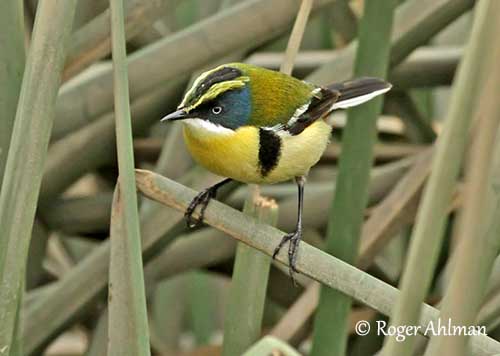
DESCRIPTION OF THE BIRD:
Biometrics:
Length: 11 cm
Weight: 6,5-8 g
The adult is brightly coloured. On the upperparts, hind neck and back up to rump are deep olive-green, whereas the uppertail-coverts are black. The tail is black with white outer rectrices. The wings are black with conspicuous white bar formed by the white edges of both wing-coverts and tertials.
On the underparts, chin, throat, foreneck and breast are bright golden yellow. There is a broad black band on each side of the breast. Belly and flanks are deep yellow. The undertail-coverts are bright red to orange, but sometimes duller, mostly pinkish.
On the head, the centre of forehead and crown is black, and a red tuft appears when the bird raises its crest. Two conspicuous golden yellow stripes extend from the bill’s base to the nape. The head sides, including lores, orbital and auricular areas are blue-black, mostly dark blue towards the nape. The latter is ochraceous, turning green towards hindneck and back.
The slender bill is black. The eyes are pale blue-grey. Long legs and strong feet are black, with yellow finger soles.
Both adults are similar, but the female is slightly smaller and duller than male.
The juvenile has the green upperparts often scaled yellow. Breast and belly are paler yellow. There is no blue on head sides and the two breast bands are absent.
SUBSPECIES AND RANGE:
The Many-coloured Rush-Tyrant has four recognized subspecies.
T.r. libertatis occurs in W Peru. This race has whiter throat and belly, and the supercilium is greener and less conspicuous than in nominate.
T.r. alticola is found in C and SE Peru and NW Argentina. This one has darker, mostly blackish-green back, and paler yellow supercilium. It is slightly larger.
T.r. loaensis is found in N Chile. This race is smaller with more white on throat. Neck and breast are mostly yellowish-ochre and the belly is pale greyish-white. The supercilium is tinged green and the outer rectrices are brighter white.
T.r. rubrigastra (described above) occurs in Paraguay, C and W Chile, Argentina and Uruguay.
HABITAT:
The Many-coloured Rush-Tyrant frequents marshy areas with thick reedbeds and rushes, and grassy areas at lake edges. This species can be seen from sea-level up to 4200 metres of elevation, but it rarely leaves its marshy habitat.
It is common in reedbeds on the shores of high-elevation lakes in the Andes, and in the lowlands of Argentina.
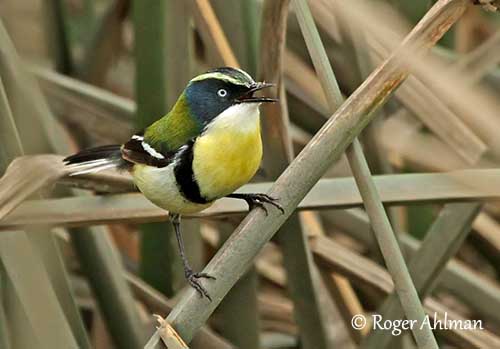
CALLS AND SONGS: SOUNDS BY XENO-CANTO
The Many-coloured Rush-Tyrant utters rapid series of insect-like notes “tic”. It also produces a whistle ending in a harsh note “piwup bzzzzt” and including other buzzing sounds.
The song is quite musical, a rich gurgled “treeutu-tu, treeutu-tu-tu-tu-tu”.
BEHAVIOUR IN THE WILD :
The Many-coloured Rush-Tyrant is usually seen in pairs or groups. This species is tame and restless, always foraging actively in dense rushes. However, in spite of its brightly coloured plumage, it is often well concealed among the vegetation.
It is an insect-eater, and takes insects, arthropods and other small invertebrates within the marshy vegetation or on the water surface.
It often perches on vertical stems and glean preys from floating vegetation and reed edges. It can cling up to the reed stems or hang upside down. The flying preys are caught by sallying from a perch. It also hops and runs on the ground, in the mud and on the floating vegetation while searching for preys.
The Many-coloured Rush-Tyrant is probably monogamous and the pair defends the territory. The courtship displays are not well known, but as this species is related to the “doraditos”, we can suggest that they perform similar behaviour including aerial displays and songs. During the displays, both in courtship and in aggressive behaviour on the nest area, the bird raises the feathers of the crown and the red tuft appears. The bright colours of the plumage are enhanced by ritual postures.
The Many-coloured Rush-Tyrant of the southernmost parts of the range migrates northwards during the austral winter and birds are recorded in S Brazil.
It flies low over the water, close to the surface, and also among the reeds. It performs short flights while foraging.
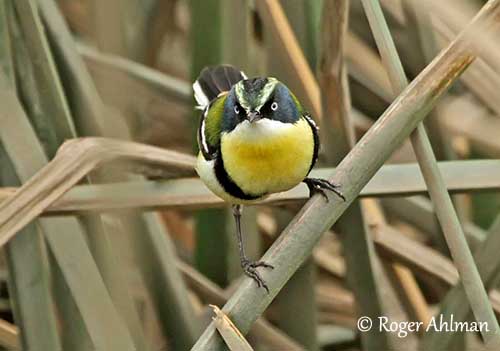
REPRODUCTION OF THIS SPECIES:
The breeding season varies according to the range, but it usually occurs between September and February. This species produces several broods per season.
The nest is a small, cone-shaped cup, attached on one side to a single reed stalk over water. It is built by the female alone with wet materials such as pieces of reed leaf. After drying, the materials look like cardboard and the rigidity maintains the shape of the nest during the continuous movements of the reed in the wind.
The female lays 2-3 creamy-white eggs. Usually, the chicks are brooded exclusively by the female, but they are fed by both parents. In the family Tyrannidae, the incubation varies from 12 to 16 days, and the chicks remain at nest during about 14-17 days. Fledglings can be seen in February in Peru and SE Brazil.
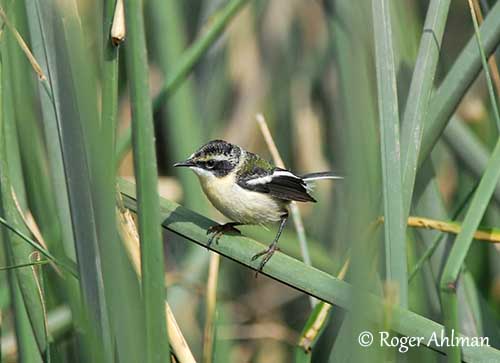
PROTECTION / THREATS / STATUS:
The Many-coloured Rush-Tyrant has large range and the population is suspected to be stable. This species is locally common in its range, and can be found in loose, scattered colonies. It also occurs in several protected areas.
Currently, the Many-coloured Rush-Tyrant is evaluated as Least Concern.
